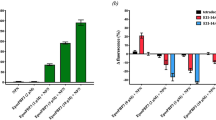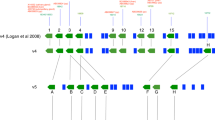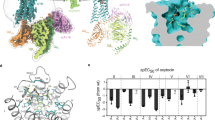Abstract
THE principal protein excreted in male rat urine, urinary α2-globulin and the homologous mouse protein, major urinary protein, have been well characterized, although their functions remain unclear. Male rat urine affects the behaviour and sexual response of female rats1, leading to the proposal that rodent urinary proteins are responsible for binding pheromones and their subsequent release from drying urine2. Urinary α2-globulin is also involved in hyaline droplet nephropathy, an important toxicological syndrome in male rats resulting from exposure to a number of industrial chemicals and characterized by the accumulation of liganded urinary α2-globulin in lysosomes in the kidney, followed by the induction of renal cancer3. We now report the three-dimensional structures of mouse major urinary protein (at 2.4 Å resolution) and rat urinary α2-globulin (at 2.8 Å resolution). The results corroborate the role of these proteins in pheromone transport and elaborate the structural basis of ligand binding.
This is a preview of subscription content, access via your institution
Access options
Subscribe to this journal
Receive 51 print issues and online access
$199.00 per year
only $3.90 per issue
Buy this article
- Purchase on Springer Link
- Instant access to full article PDF
Prices may be subject to local taxes which are calculated during checkout
Similar content being viewed by others
References
Cowley, J. J. Biological Determinants of Sexual Behaviour (ed. Hutchinson, J. B.) 87–125 (Wiley. Chichester, 1978).
Cavaggioni, A., Sorbi, R. T., Keen, J. N., Pappin, D. J. C. & Findlay, J. B. C. FEBS Lett. 212, 225–228 (1987).
Borghoff, S. J., Short, B. G. & Swenberg, J. A. Rev. Pharmac. Toxicol. 30, 349–367 (1990).
Flower, D. R., North, A. C. T. & Attwood, T. K. Biochim. biophys. Res. Commun. 180, 69–74 (1991).
Tirindelli, R., Keen, J. N., Cavaggioni, A., Eliopoulos, E. E. & Findlay, J. B. C. Eur. J. Biochem. 185, 569–572 (1989).
Sivaprasadarao, A. & Findlay, J. B. C. Biochem. J. 255, 561–569 (1988).
Böcskei, Z. et al. J. molec. Biol. 218, 699–701 (1991).
Bacchini, A., Gaetani, E. & Cavaggioni, A. Experimentia (in the press).
Cavaggioni, A., Findlay, J. B. C. & Tirindelli, R. Comp. Biochem. Physiol. 96b, 513–520 (1990).
Kimura, H. et al. J. biol Chem. 266, 5963–5972 (1991).
Kabsch, W. J. appl. Crystallogr. 21, 67–71 (1988).
Wang, B. C. Meth. Enzym. 115, 90–112 (1985).
Cherfils, J. & Dumas, C. J. appl. Crystallogr. 21, 985–987 (1988).
Brunger, A. T., Kuriyan, J. & Karplus, M. Science 235, 458–460 (1987).
Hendrickson, W. A. Meth. Enzym. 115, 252–270 (1985).
Fitzgerald, P. M. D. J. appl. Crystallogr 21, 273–288 (1988).
Jones, T. A. Meth. Enzym. 115, 157–171 (1985).
Cowan, S. W., Newcomer, M. E. & Jones, T. A. Proteins 8, 44–61 (1990).
Papiz, M. A. et al. Nature 324, 383–385 (1986).
Clark, A. J., Ghazal, P., Bingham, R. W., Barrett, P. & Bishop, J. O. EMBO J. 4, 3159–3159 (1985).
Clark, A. J., Clissold, P. M., Shawi, R. A., Beattie, P. & Bishop, J. O. EMBO J. 3, 1045–1052 (1984).
Ichiyoshi, Y., Endo, H. & Yamamoto, M. Biochim biophys. Acta 910, 43–51 (1987).
Parry-Smith, D. J. & Attwood, T. K. CABIOS 7, 233–235 (1991).
North, A. C. T. Biochem. Soc. Symp. 57, 35–48 (1991).
Holden, H. M., Rypniewsky, W. R., Law, J. H. & Rayment, I. EMBO J. 6, 1565–1570 (1987).
Huber, R. et al. J. molec. Biol. 195, 423–434 (1987).
Flower, D. R. J. molec. Graph 9, 257–258 (1991).
Author information
Authors and Affiliations
Rights and permissions
About this article
Cite this article
Böcskei, Z., Groom, C., Flower, D. et al. Pheromone binding to two rodent urinary proteins revealed by X-ray crystallography. Nature 360, 186–188 (1992). https://doi.org/10.1038/360186a0
Received:
Accepted:
Issue Date:
DOI: https://doi.org/10.1038/360186a0
This article is cited by
-
Probe-dependence of competitive fluorescent ligand binding assays to odorant-binding proteins
Analytical and Bioanalytical Chemistry (2020)
-
Update on the human and mouse lipocalin (LCN) gene family, including evidence the mouse Mup cluster is result of an “evolutionary bloom”
Human Genomics (2019)
-
Effects of point mutations in the binding pocket of the mouse major urinary protein MUP20 on ligand affinity and specificity
Scientific Reports (2019)
-
Molecular complexity of the major urinary protein system of the Norway rat, Rattus norvegicus
Scientific Reports (2019)
-
Buffalo nasal odorant-binding protein (bunOBP) and its structural evaluation with putative pheromones
Scientific Reports (2018)
Comments
By submitting a comment you agree to abide by our Terms and Community Guidelines. If you find something abusive or that does not comply with our terms or guidelines please flag it as inappropriate.



